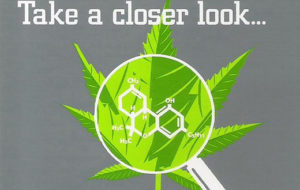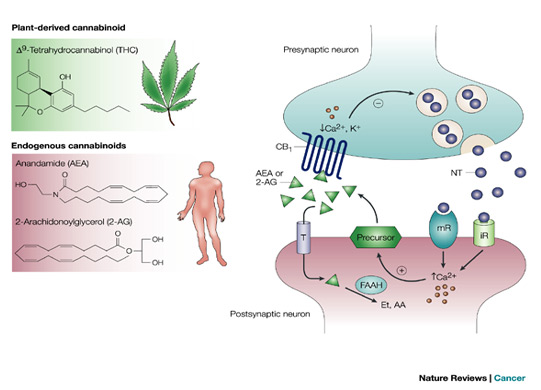
Cannabis has been a part of human history for a millennium. Until the early 20th century, it was used as medicine and a spiritual guide in cultures all over the planet.
In the early 1900’s it was possible to purchase cannabis tincture at pharmacies, but soon the United States federal government launched a crusade to prohibit this most intriguing plant.
For the last 80 years or so, the major drivers of medical research, pharmaceutical companies, have focused on profitable synthetic drugs and little research has been done on cannabis chemistry and therapeutic applications.
Cannabis Chemistry In Main Stream News
 When television personalities like Dr. Oz and Sanjay Gupta are talking about it, it is clear that a wave of change is swelling. Cannabis chemistry contains is much more than a normal plant; it is a gift to humanity with complex scientific secrets.
When television personalities like Dr. Oz and Sanjay Gupta are talking about it, it is clear that a wave of change is swelling. Cannabis chemistry contains is much more than a normal plant; it is a gift to humanity with complex scientific secrets.
If you were to walk down the street and ask people what chemicals they associate with marijuana, the overwhelming majority would say THC (and maybe CBD if they saw Dr. Gupta on CNN).
While cannabinoids like THC and CBD are well known and often thought of as the active ingredients in cannabis chemistry, there are a huge number of other chemicals present in the plant.
To fully understand the medical applications or to produce quality concentrates or marijuana-infused products, a basic understanding of the science is critical. In addition to the better-known cannabinoids THC and CBD, there are dozens of other related cannabinoids found in the plant’s cannabis chemistry.
THCA is the natural product version of THC and understanding the chemistry of these two compounds is of utmost importance. Compounds such as CBC and CBG are chemical precursors in the plant biosynthesis of THC and have been shown to have interesting medical properties.
CBN is a degradation product of THC that has unique physiological effects.
Terpenoids In Cannabis Chemistry
 There is also an entire class of compounds called terpenoids that are chemical building blocks to make cannabinoids.
There is also an entire class of compounds called terpenoids that are chemical building blocks to make cannabinoids.
The medical properties of terpenoids are not nearly as well known, but there are certainly some interesting remedies waiting to be discovered in this broad class of chemical compounds.
Cannabinoids and terpenoids are made up of simple chemical building blocks called terpenes.
Terpenes are volatile, small molecules that give cannabis much of its flavor and aroma. They also have unique medical properties and are present in many other plants. Terpenes can be found in pine trees, citrus fruit, and flowers such as lavender and so on.
There is a growing industry across the globe that is focused on using essential oils as therapy for a variety of ailments, so retaining terpenes in concentrates is important for medical reasons. It is also important to understand terpene chemistry as it greatly impacts the texture and flavor of cannabis concentrates.
Compounds In Cannabis Chemistry
 In addition to the ever-intriguing cannabinoids, terpenoids, and terpenes, cannabis chemistry also contains several other ubiquitous chemical compounds found in many other living things.
In addition to the ever-intriguing cannabinoids, terpenoids, and terpenes, cannabis chemistry also contains several other ubiquitous chemical compounds found in many other living things.
Cannabis chemistry contains proteins and enzymes, starches and carbohydrates, waxes and other oils as well as chlorophyll and other common plant chemicals.
While these are not psychoactive and have minimal medical value, it is important to consider these components of cannabis chemistry as well.
They can greatly affect the color, flavor, and texture of concentrates and infused products. Cannabinoids are found throughout virtually the entire cannabis plant at all stages of growth, from seedlings to harvested flowers.
The flowers of the cannabis plant are by far the most potent component in terms of THC and CBD and other cannabinoids in its chemistry. However, the stems and leaves also contain a relatively small amount of cannabinoids.
Cannabis flowers typically test from 10-30% for THC by weight, while leaves and stems are typically 1-5% THC. Each strain of cannabis has a specific cannabinoid profile with THC, CBD, and others present in specific ratios.
While the percent of cannabinoid present in the various parts of the plant will vary, the profile remains pretty much the same for a given strain. Because of recent reports of the medical properties of CBD, there has been significant interest in breeding strains with a high CBD content.
Hemp is also a significant source of CBD and other cannabinoids but is subject to different federal and local regulations. Because THC is the primary psychoactive ingredient in cannabis chemistry, it is the most interesting cannabinoid to many people.
A basic understanding of how THC is made in the cannabis plant is essential for anyone who wants to work with cannabis. As mentioned previously, THCA is a natural product formed biosynthetically by cannabis. Unlike THC, THCA is not psychoactive when consumed.
Curing Process & Cannabis Chemistry
During the curing process, THCA in flowers is converted to THC through a process called decarboxylation. This process is also referred to as conversion, activation, or decarbing. During decarboxylation,n, the THCA undergoes a chemical change where it gives off carbon dioxide gas to form THC.
This conversion also takes place when the flowers are heated as they are smoked or vaporized, so even flowers that are not fully decarboxylated will be psychoactive. For edibles and other products that will not be heated before ingestion, it is important to know how much THC and THCA are present so that the proper dose can be formulated.
Activating Cannabis (THCA -> THC)
 Complete conversion of THCA to THC is simple and can be achieved by heating above 210 °F for extended periods.
Complete conversion of THCA to THC is simple and can be achieved by heating above 210 °F for extended periods.
The plant material can be activated before extraction, or the concentrate itself can be decarbed to ensure that all THCA is converted to THC for infused products and this process will be discussed in a subsequent laboratory course.
Cannabinoids, terpenoids, and terpenes are all hydrophobic chemical compounds, meaning they are not very soluble in water but dissolve easily in oils and organic solvents. For this reason, solvents like butane or alcohol are popular methods of extracting cannabis.
It is possible to use water to make bubble hash, but that is a physical separation and not a true extraction where the THC and other plant oils are dissolved in a solvent. The choice of extraction solvent can greatly impact the type and quality of concentrate that will be produced.
Compared to terpenes, cannabinoids have relatively high boiling points above 350 °F while many terpenes boil at less than 200 °F. This difference in boiling point can be used to separate components by distillation in some applications.
It is also important to keep these numbers in mind while purging or decarbing because terpenes may be lost in the process impacting the flavor, texture, and physiological effects of a concentrate or infused product. THCA and CBD are both solids in their pure form, while THC is a thick oil.
Terpenes tend to be thin liquids, although some are crystalline solids at room temperature. Cannabinoids do not only differ in physical and chemical properties as we have just seen, but they also have varying effects on the human body when ingested.
You know that THCA, present in fresh plant material, is not psychoactive and must be heated to convert to THC before consumption to get high.
CBD is not considered to be psychoactive and is a cannabinoid receptor antagonist which means that it counters the effects of THC in the brain. However, CBD is claimed to help with pain, inflammation, seizures, mental illness, and many other ailments so there is much demand for it, even though it does not induce a high.
CBN is a degradation product of THC and is known to cause drowsiness when ingested. Other, lesser-known cannabinoids like CBC and CBG have not been studied as well. As the science around cannabis chemistry advances, there will be more and more clinical studies to determine how natural and synthetic cannabinoids affect our bodies and minds.
You should now have a basic understanding of the broad classes of chemicals that are found in cannabis chemistry, their physical and chemical chemistry properties, and how they affect users.
Let us know what you think.




Responses